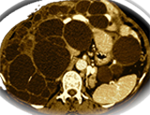Sclerosing
♦Simple cyst Drainage
♦Sclerosing with Alcohol
♦Fenestration Laparoscope
♦Deroofing
♦Marsupialization
Simple cyst drainage, alcohol sclerosing, laparoscopic fenestration, deroofing and marsupialization are done as temporary fixes for symptomatic pain relief. A review of the literature indicates these procedures, can take as long to perform as some liver resections. Almost always these procedures need to be repeated, sometimes twice within a year. If the doctor has experience with polycystic liver cysts, he will likely say that eventually there is a need for either a liver transplant or a liver resection. However, not everyone with liver cysts requires a surgical de-bulking procedure, only 8% or those with severe polycystic liver disease may find it necessary to seek out a liver resection or a liver transplant. The other 92% have few if any symptoms from their polycystic liver.
Procedures for Relieving Pain
Sometimes we do not wish to have a liver resection or a liver transplant. Some of us may have been told a liver resection is not something we will ever need. Others may not want undergo such a big surgery. Other may have been told they are not a candidate for either procedure. Still others may not wish to have a lifetime of transplant drugs. There are various reasons why we might seek out temporary relief from PLD symptoms and not wish to undergo a huge de-bulking surgical procedure.
Some are willing to have twice-yearly smaller procedures to relieve their symptoms. Many realize these procedures need repeating but are willing to undergo these procedures for the temporary symptomatic relief. Others have had great success with dietary changes alone. Still others have noticed by adhering to the PLD Diet, they need these procedures less frequently.
♦Simple Cyst Drainage with Sand Bags
I heard from a courageous German lady who allowed her story to be posted. She has had several simple cyst drainages performed with sandbags and done at Charité Hospital in Germany. This procedure has been repeated on several occasions with success.
For (2) two hours following the procedure Marie-Louise holds very still with sand bag compression over the drainage site. She feels that since trying the PLD Diet, this has allowed her to extend the time interval between procedures. Simple cyst drainage is preformed in more places than in Germany, and sandbags are not always used. Simple Cyst Drainage.
♦Sclerosing Alcohol
This seems to be the least favorite and the most painful of the procedures. Performed by an interventional radiologist, fluid is withdrawn from the cyst then alcohol or ethanol is injected into the empty cyst cavity. One individual had this done at Massachusetts General Hospital in Boston and would never have it done again. She found it too painful and it left too much scarring. Another person had this done and the alcohol leaked into the pancreas causing pancreatitis. Sometimes glue can be used to adhere the cyst edges together. It seems doctors in Sweden have ceased using alcohol because it causes too much pain.
(3) three dominant liver cysts are squeezing my inferior vena cava, this happens to be the biggest vein in my body. These 3 liver cysts are compromising the venous blood return to my heart. There is a 90% compression. Sclerosing the offending liver cysts improves blood flow to my heart. In the meantime I have tried daily exercise pumping my calf muscles, using a stair master device. My return blood flow to my heart has been compromised going on 17 years. It is noted on imaging that my hemiazygos vein has enlarged taking upon itself part of the workload of the inferior vena cava. All was delicately balanced until I got very sick with an intracyst infection requiring two weeks of bed rest. I got swelling of my legs and extreme tiredness. The sclerosing was considered too dangerous for me and it was not done.
Some researchers have tried coupling sclerotherapy with pasireotide treatment to maintain cyst reduction. Note the treatment for infections from sclerotherapy seems to resolve with ciprofloxacin.
♦Fenestration Laparoscopic
The creation of an artificial opening into a cyst, like a window. Drains can be placed to help absorb the fluid. This can be done laparoscopically or with open surgery through an incision. This is done under general anesthesia and performed by a transplant surgeon. With a laparoscope, the surgeon, cuts across the cyst and drains it. When done with a scope, this is considered day surgery, with the option of an overnight stay. No alcohol or ethanol is used.
♦Deroofing
A surgeon takes the top off a cyst as if it were an egg, laying on its long side. Drains may be placed to help absorb the fluid. This can be done laparoscopically or with open surgery through an incision. It is usually done under general anesthesia and can be performed by a transplant surgeon.
♦Marsupialization
Under anesthesia, the cyst sac is opened and emptied. Its edges are sutured to adjacent tissues; a drain may be left in place. Over a period, the secretions will decrease and the sac space will be reduced until it is completely gone.
♦More Information
This article discusses scleroscopy performed by a radiologist at Tufts University.
The following article in Table 4, explains many differences.
Here is a case report of a 61 y/o woman with two previous laparoscopic procedures at Massachusetts General Hospital.
Marie-Louise explains in great detail how her procedure is performed in Germany without any alcohol injections. She has it repeated every 2-3 years.
Two weeks prior to surgery these are items to be avoided. Following surgery there are certain beneficial things to try.
